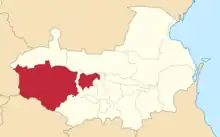Nalchiksky okrug
The Nalchiksky okrug[lower-alpha 1] was a district (okrug) of the Terek Oblast of the Caucasus Viceroyalty of the Russian Empire. The area of the Nalchiksky okrug made up part of the North Caucasian Federal District of Russia. The district was eponymously named for its administrative center, Nalchik.[1]
Nalchiksky okrug
Нальчикскій округъ | |
|---|---|
 Location in the Terek Oblast | |
| Country | Russian Empire |
| Viceroyalty | Caucasus |
| Oblast | Terek |
| Established | 1882 |
| Abolished | 1921 |
| Capital | Nalchik |
| Area | |
| • Total | 11,902.25 km2 (4,595.48 sq mi) |
| Population (1916) | |
| • Total | 180,534 |
| • Density | 15/km2 (39/sq mi) |
| • Rural | 100.00% |
Administrative divisions
The subcounties (uchastoks) of the Nalchiksky okrug were as follows:[2]
| Name | 1912 population |
|---|---|
| 1-y uchastok (1-й участокъ) | 45,902 |
| 2-y uchastok (2-й участокъ) | 26,735 |
| 3-y uchastok (3-й участокъ) | 40,296 |
| 4-y uchastok (4-й участокъ) | 21,755 |
Demographics
Russian Empire Census
According to the Russian Empire Census, the Nalchiksky okrug had a population of 102,908 on 28 January [O.S. 15 January] 1897, including 53,203 men and 49,705 women. The majority of the population indicated Kabardian to be their mother tongue, with a significant Tatar[lower-alpha 2] speaking minority.[5]
| Language | Native speakers | % |
|---|---|---|
| Kabardian | 64,746 | 62.92 |
| Tatar[lower-alpha 2] | 23,184 | 22.53 |
| Russian | 4,811 | 4.68 |
| Ukrainian | 4,745 | 4.61 |
| Ossetian | 2,728 | 2.65 |
| Jewish | 1,108 | 1.08 |
| German | 973 | 0.95 |
| Kumyk | 116 | 0.11 |
| Georgian | 105 | 0.10 |
| Armenian | 87 | 0.08 |
| Polish | 61 | 0.06 |
| Persian | 40 | 0.04 |
| Ingush | 36 | 0.03 |
| Kazi-Kumukh | 30 | 0.03 |
| Belarusian | 16 | 0.02 |
| Romani | 16 | 0.02 |
| Avar-Andean | 6 | 0.01 |
| Karachay | 6 | 0.01 |
| Lithuanian | 6 | 0.01 |
| Chechen | 4 | 0.00 |
| Bashkir | 3 | 0.00 |
| Nogai | 3 | 0.00 |
| Circassian | 2 | 0.00 |
| Romanian | 1 | 0.00 |
| Other | 75 | 0.07 |
| TOTAL | 102,908 | 100.00 |
Kavkazskiy kalendar
According to the 1917 publication of Kavkazskiy kalendar, the Nalchiksky okrug had a population of 180,534 on 14 January [O.S. 1 January] 1916, including 95,010 men and 85,524 women, 163,765 of whom were the permanent population, and 16,769 were temporary residents:[6]
| Nationality | Number | % |
|---|---|---|
| North Caucasians | 134,390 | 74.44 |
| Russians | 37,810 | 20.94 |
| Other Europeans | 5,299 | 2.94 |
| Roma | 1,660 | 0.92 |
| Jews | 1,025 | 0.57 |
| Armenians | 350 | 0.19 |
| TOTAL | 180,534 | 100.00 |
Notes
References
- Tsutsiev 2014.
- Кавказский календарь на 1913 год, pp. 180–187.
- Волкова 1973, p. 87.
- Tsutsiev 2014, p. 50.
- "Демоскоп Weekly - Приложение. Справочник статистических показателей". www.demoscope.ru. Retrieved 2022-07-09.
- Кавказский календарь на 1917 год, pp. 226–237.
Bibliography
English sources
- Bournoutian, George A. (2018). Armenia and Imperial Decline: The Yerevan Province, 1900–1914. Milton Park, Abingdon, Oxon: Routledge. ISBN 978-1-351-06260-2. OCLC 1037283914.
- Tsutsiev, Arthur (2014). Atlas of the Ethno-Political History of the Caucasus (PDF). Translated by Nora Seligman Favorov. New Haven: Yale University Press. ISBN 9780300153088. Archived (PDF) from the original on 17 June 2023.
Russian sources
- Волкова, Н. Г. (1973). Лавров, Л. И. (ed.). Этнонимы и племенные названия Северного Кавказа [Ethnonyms and tribal names of the North Caucasus] (in Russian). Москва: Наука. pp. 1–210.
- Кавказский календарь на 1913 год [Caucasian calendar for 1913] (in Russian) (68th ed.). Tiflis: Tipografiya kantselyarii Ye.I.V. na Kavkaze, kazenny dom. 1913. Archived from the original on 19 April 2022.
- Кавказский календарь на 1917 год [Caucasian calendar for 1917] (in Russian) (72nd ed.). Tiflis: Tipografiya kantselyarii Ye.I.V. na Kavkaze, kazenny dom. 1917. Archived from the original on 4 November 2021.